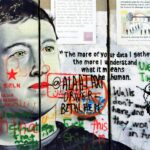Ayn Rand and the Value of Creative Expression
Ayn Rand’s objectivist philosophy holds as its highest precept the individual’s ability to live for himself. But this is not, as some critics allege, an invitation to hedonism. Nor is it only some ephemeral abstraction. Rand’s philosophy requires the individual to use his consciousness to seek and pursue values as a means of his philosophical survival. It also necessitates a way to communicate moral ideas. For Rand, that’s art, which technology’s obliteration of gatekeepers has made more accessible than ever.
Rand’s idealized individual has a productive mandate, a need to transfer the values that animate his being into the products of his labor. As Rand wrote in The Romantic Manifesto, “a rational man needs a concretized projection of these values, an image in whose likeness he will re-shape the world and himself. Art gives him that image: it gives him the experience of seeing the full, immediate, concrete reality of his distant goals.”
Art is the reminder that the moral values the rational man desires and orders his life around can move from the abstract realm of thought and into tangible reality. It stands as proof positive that the world that individual desires can be won, important in the face of constant criticism which individuals with radical ideas often face.
By art, Rand does not mean only conventional art forms, such as painting or sculpture. Howard Roark, the protagonist of The Fountainhead, is an architect. In Atlas Shrugged, Hank Rearden invents a new type of steel. Both are artists, whose philosophy and integrity is manifest in their work.
Roark’s architecture is animated by a single idea, which dictates every detail. Everything is secondary to the development of that idea, even his clients’ needs. It logically follows that, if the idea is sound, these will be fulfilled. But not everyone in the novel sees this. When challenged about his seeming callousness, Roark proclaims that he does not build in order to have clients. He has clients in order to build.
That others derive value from his meaning is secondary to the meaning he derives from them. And even that is secondary to the meaning derived from the productive act of bringing value into being. In this, The Fountainhead mirrors Rand’s primary goal in writing her novels, which is to portray her heroes as an end to themselves.
But this objective is complicated, both in Rand’s literary worlds and in the real world, by detractors. Within their respective novels, Rand’s heroes struggle against ingrained social attitudes that reject individual achievement and demand subordination to the common good.
Rand herself experienced pushback against her work, deemed too controversial by twelve publishers who rejected The Fountainhead.
Rand and her heroes ultimately prevailed against gatekeepers. But, in the real world, the persecution of the individual with a radical idea or dream often doesn’t have such a happy ending.
But the advent of new technologies is rendering many gatekeepers obsolete. No longer do authors like Rand need to struggle to have manuscripts read. Self-publishing a book through Amazon can be done at little cost, and marketed cheaply through social media. For musicians, podcasters, and artists, social media also presents an opportunity to produce and market their work, as do video streaming platforms like YouTube.
As a result, individual creativity is less subordinated to publishers’ ideas about what their collective audience desires. An individual with a radical creative vision doesn’t have to waste time arguing about the merit of his work or the values it promotes. He can simply put that work out into the world and turn his attention to promoting other works of value, bringing more and more of the things he values most highly into the world. By doing so, he promotes his own philosophical survival.
There are still detractors, of course. The proliferation of self-made art has generated much hand-wringing, as have artificial intelligence (AI) programs that have begun to credibly replicate art and prose. Critics fear machines will push aside and devalue true art.
But that’s the point of Rand’s philosophy: value in art is intrinsic. It’s a reflection of the self, of the values one pours into something. AI art may be a shortcut through some skill sets, but it doesn’t replace the spark of imagination needed to inspire a particular work of art.
As AI makes the ability to make art more accessible to people of all skills, Rand’s productive mandate becomes easier to fulfill. For the individual, it represents the promise of a life lived in closer contact with prized values, which is good for the soul. That capitalism, which Rand championed because it allowed value to be pursued through volitional transactions between individuals who recognized shared values, has brought about this new era of productive achievement, is fitting.




